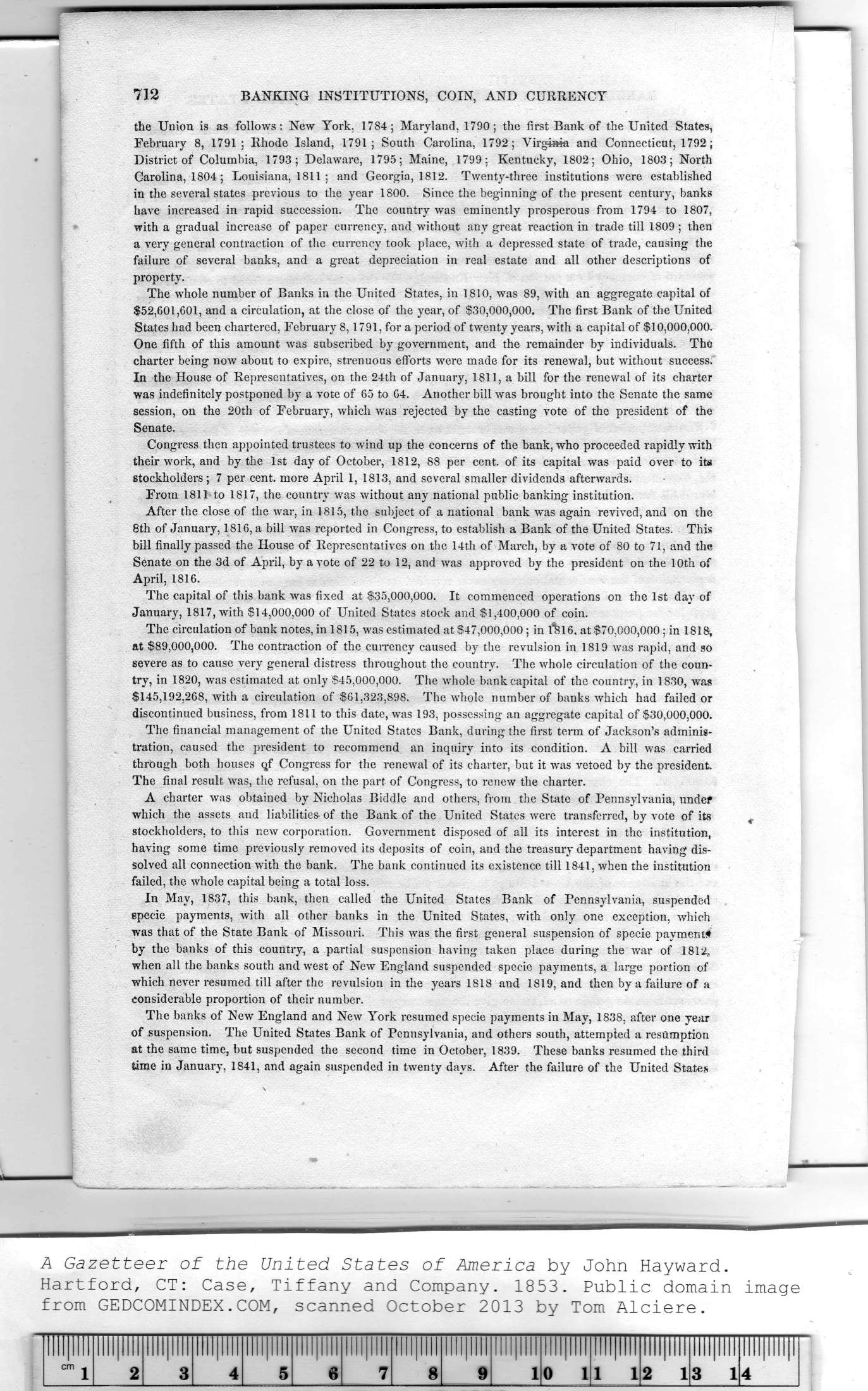|
|
Note: Ctrl and + increases the font size of the text below, Ctrl and - decreases it, and Ctrl and 0 resets it to default size.
712 BANKING INSTITUTIONS, COIN, AND CURRENCY
the Union is as follows: New York. 1784; Maryland, 1790; the first Bank of the United States,
February 8, 1791 ; Rhode Island, 1791 ; South Carolina, 1792; Virginia and Connecticut, 1792;
District of Columbia, 1793; Delaware, 1795; Maine, 1799; Kentucky, 1802; Ohio, 1803; North
Carolina, 1804; Louisiana, 1811 ; and Georgia, 1812. Twenty-three institutions were established
in the several states previous to the year 1800. Since the beginning of the present century, banks
have increased in rapid succession. The country was eminently prosperous from 1794 to 1807,
with a gradual increase of paper currency, and without any great reaction in trade till 1809 ; then
a very general contraction of the currency took place, with a depressed state of trade, causing the
failure of several banks, and a great depreciation in real estate and all other descriptions of
property.
The whole number of Banks in the United States, in 1810, was 89, with an aggregate capital of
$52,601,601, and a circulation, at the close of the year, of $30,000,000. The first Bank of the United
States had been chartered, February 8,1791, for a period of twenty years, with a capital of $10,000,000.
One fifth of this amount was subscribed by government, and the remainder by individuals. The
charter being now about to expire, strenuous efforts were made for its renewal, but without success.
In the House of Representatives, on the 24th of January, 1811, a bill for the renewal of its charter
was indefinitely postponed by a vote of 65 to 64. Another bill was brought into the Senate the same
session, on the 20th of February, which was rejected by the casting vote of the president of the
Senate.
Congress then appointed trustees to wind up the concerns of the bank, who proceeded rapidly with
their work, and by the 1st day of October, 1812, 88 per cent, of its capital was paid over to its
stockholders; 7 per cent, more April 1, 1813, and several smaller dividends afterwards.
From 1811 to 1817, the country was without any national public banking institution.
After the close of the war, in 1815, the subject of a national bank was again revived, and on the
8th of January, 1816, a bill was reported in Congress, to establish a Bank of the United States. This
bill finally passed the House of Representatives on the 14th of March, by a vote of 80 to 71, and the
Senate on the 3d of April, by a vote of 22 to 12, and was approved by the president on the 10th of
April, 1816.
The capital of this bank was fixed at $35,000,000. It commenced operations on the 1st day of
January, 1817, with $14,000,000 of United States stock and $1,400,000 of coin.
The circulation of bank notes, in 1815, was estimated at $47,000,000; in 1*816. at $70,000,000; in 1818,
at $89,000,000. The contraction of the currency caused by the revulsion in 1819 was rapid, and so
severe as to cause very general distress throughout the country. The whole circulation of the coun-
try, in 1820, was estimated at only $45,000,000. The whole bank capital of the country, in 1830, was
$145,192,268, with a circulation of $61,323,898. The whole number of banks which had failed or
discontinued business, from 1811 to this date, was 193, possessing an aggregate capital of $30,000,000.
The financial management of the United States Bank, during the first term of Jackson's adminis-
tration, caused the president to recommend an inquiry into its condition. A bill was carried
through both houses qf Congress for the renewal of its charter, but it was vetoed by the president.
The final result was, the refusal, on the part of Congress, to renew the charter.
A charter was obtained by Nicholas Biddle and others, from the State of Pennsylvania, undef
which the assets and liabilities of the Bank of the United States were transferred, by vote of its
stockholders, to this new corporation. Government disposed of all its interest in the institution,
having some time previously removed its deposits of coin, and the treasury department having dis-
solved all connection with the bank. The bank continued its existence till 1841, when the institution
failed, the whole capital being a total loss.
In May, 1837, this bank, then called the United States Bank of Pennsylvania, suspended
specie payments, with all other banks in the United States, with only one exception, which
was that of the State Bank of Missouri. This was the first general suspension of specie payment#
by the banks of this country, a partial suspension having taken place during the war of 1812,,
when all the banks south and west of New England suspended specie payments, a large portion of
which never resumed till after the revulsion in the years 1818 and 1819, and then by a failure of a
considerable proportion of their number.
The banks of New England and New York resumed specie payments in May, 1838, after one year
of suspension. The United States Bank of Pennsylvania, and others south, attempted a resumption
at the same time, but suspended the second time in October, 1839. These banks resumed the third
time in January, 1841, and again suspended in twenty days. After the failure of the United States
A Gazetteer of the United States of America by John Hayward.
Hartford, CT: Case, Tiffany and Company. 1853. Public domain
|
